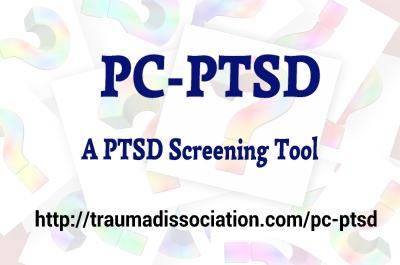Primary Care PTSD Screen (PC-PTSD)
PC-PTSD
 The PC-PTSD is a screening tool for Posttraumatic Stress Disorder.[1] It has four questions and is design for clinical use. .[3] It is not designed to give a definitive diagnosis of PTSD, it is used to assess whether a clinical interview should be carried out for PTSD.[3]
The PC-PTSD is a screening tool for Posttraumatic Stress Disorder.[1] It has four questions and is design for clinical use. .[3] It is not designed to give a definitive diagnosis of PTSD, it is used to assess whether a clinical interview should be carried out for PTSD.[3] Instructions:
Choose Yes or No for each question. There are 4 questions. These questions have been designed for adults. If you would prefer to answer questions on paper, then you can download a printable version of this screening tool.
Result Explained
A score or 3 or 4 gives a "positive" result on the tool. Scores of 2 or less give a "negative" result. A positive result indicates that you may have Posttraumatic Stess Disorder, which can be determined by a clinical interview.[3] This screening tool is not a replacement for advice from a medical/clinical professional.
References>
1. Prins, A., Ouimette, P., Kimerling, R., Cameron, R. P., Hugelshofer, D. S., Shaw-Hegwer, J., Thrailkill, A., Gusman, F.D., Sheikh, J. I. (2003). The primary care PTSD screen (PC-PTSD): development and operating characteristics. Primary Care Psychiatry, 9, 9-14
2. Prins, A., Ouimette, P., Kimerling, R., Cameron, R. P., Hugelshofer, D. S., Shaw-Hegwer, J., Thrailkill, A., Gusman, F.D., Sheikh, J. I. (2004). The primary care PTSD screen (PC-PTSD): Corrigendum. Primary Care Psychiatry, 9, 151
3. Primary Care PTSD Screen (PC-PTSD). (n.d.) Retrieved June 2, 2015, from http://www.ptsd.va.gov/professional/assessment/screens/pc-ptsd.asp
Cite this page
Primary Care PTSD Screen (PC-PTSD) Traumadissociation.com. Retrieved from .The copyright for the questions, answers and scoring method belong to the original authors of the research. See references.[1]
The remaining information can be copied or modified for any purpose, including commercially, provided a link back is included. License: CC BY-SA 4.0
